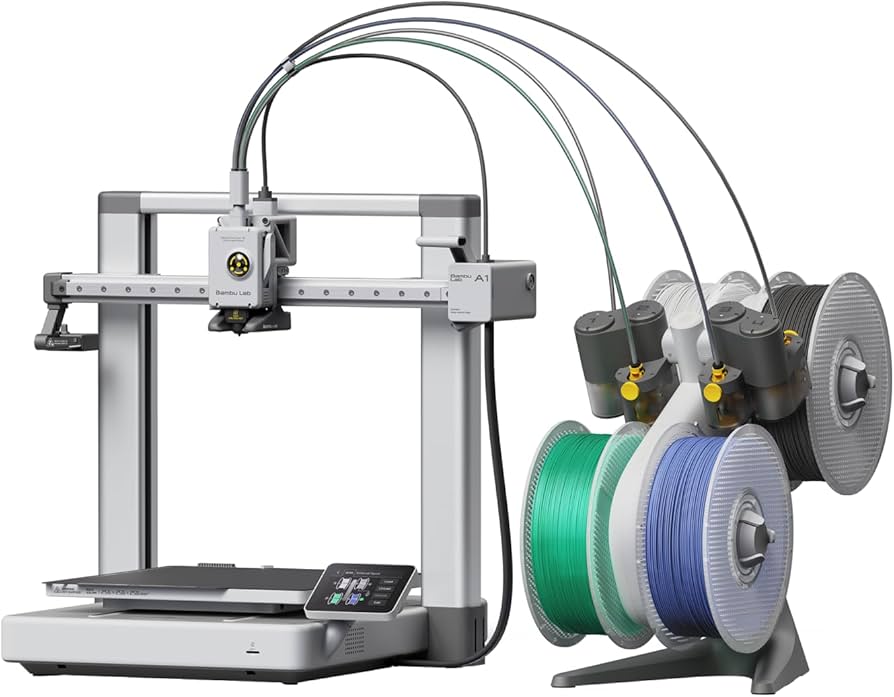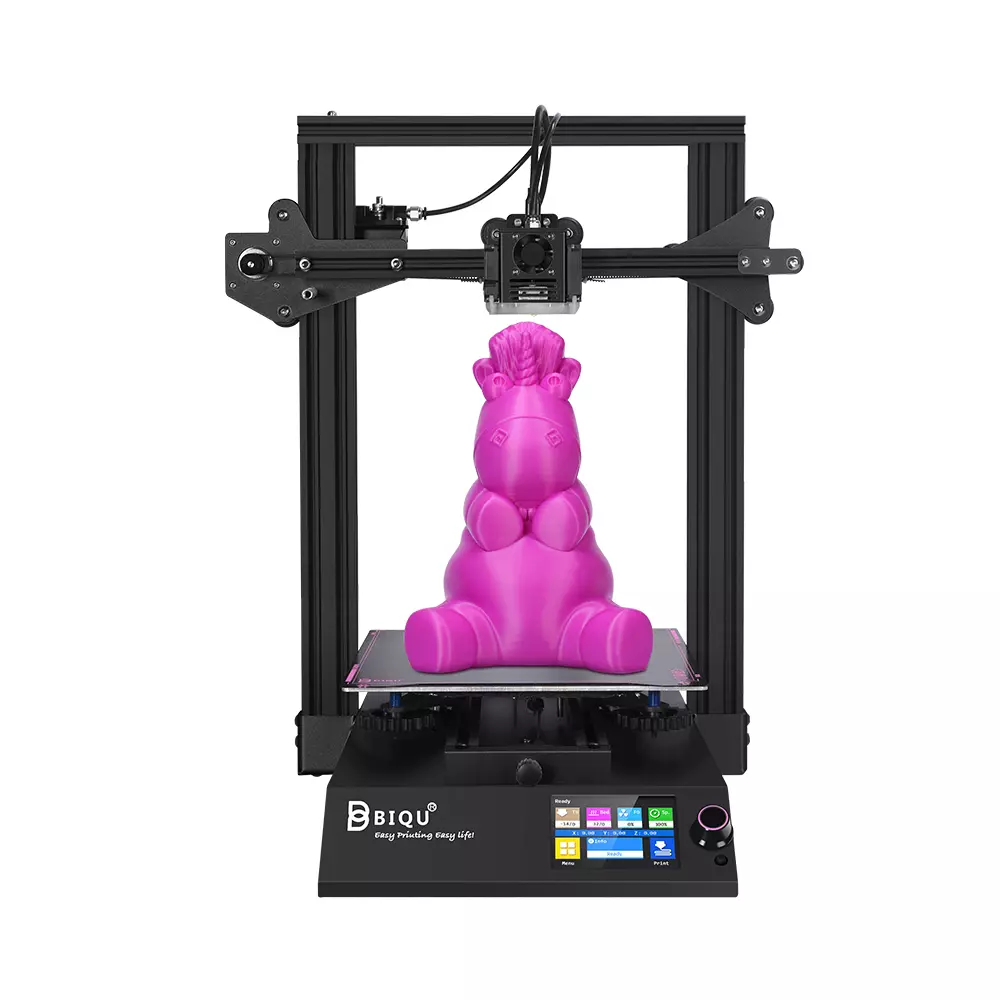Compare A1 vs BIQU B1
Comparison between the best 3D printers
Choose the best 3D printer at the best price. The cheapest 3D printers are here.
Buy a 3D printer here with 3D Fila.
 |
 |
|
| Model | A1[BUY A1] |
BIQU B1 |
| Printing Material | Filament | Filament |
| Buy Filament for Bambu Lab A1 | Buy Filament forBigTreeTech BIQU B1 | |
| Estimated price | $700,00 | $269,00 |
| Manufacturer | Bambu Lab | BigTreeTech |
| Release Year | 2023 | 2020 |
| Print Volume [mm] | 256x256x256 | 235x235x270 |
| Printer Size [mm] | 385x410x430 | 412x402x492 |
| Weight [kg] | 8,3 | 8,00 |
| Power Loss Recovery | YES | YES |
| Enclosed printer | NO | NO |
| Bed Leveling | Automatic | Manual |
| Filament End Sensor | YES | YES |
| Bed type | Heated | Heated |
| Power supply system | Direct Drive | Bowden |
| Standard nozzle | 0,4 | 0,4 |
| Maximum Nozzle Temperature [°C] | 300 | 250 |
| Maximum Bed Temperature [°C] | 100 | 100 |
| Maximum printing speed [mm/s] | 500 | 100 |
| Filament holder | YES | YES |
| Camera for supervision | YES | YES |
| Recommended filaments | PLA, PETG, TPU, PVA | PLA, TPU, ABS, PETG |
| Recommended slicers | SuperSlicer, PrusaSlicer, Cura, OrcaSlicer | Cura, Simplify, Slic3r |
| Maximum Resolution [mm] | 0,1 | 0,1 |
| Processor | 32 Bits BTT SKR V 1.4 | |
| Display | Touchscreen 3,5 | Touchscreen TFT 3,5'' |
| Power Supply | 350 W | 24V / 360W |
| Connectivity | Wi-Fi, Bambu-Bus, Cartão Micro SD | SD / USB |
| Operating systems | Windows, Linux, Macbook | Windows, Mac, Linux |
| Date of registration in the system | 2024-07-17 | 2021-04-14 |
| Release date | 2023 | 2020 |
| Extra features | The BambuLab A1 printer features fully automatic calibration, multi-color printing with the AMS system, active flow rate compensation, quick nozzle change with a clip, active motor noise cancellation, a build volume of 256x256x256 mm³, a maximum extruder temperature of 300°C, and a heated bed of up to 100°C. In addition, it has high precision, a machine health management system and an intuitive 3.5-inch touchscreen interface. | The BIQU B1 is an advanced 3D printer with a silent 32-bit BTT SKR V1.4 motherboard and ARM Cortex-M3 CPU, offering DIY interfaces (I2C, SPI, WiFi) and dual Z-axis. Its dual BTT B1 TFT35 V3.0 operating system allows real-time monitoring and multiple printing modes, including G-code visualization effects. It stands out for its BIQU SSS (Super Spring Steel), ensuring easy model adhesion and simplified removal, with the possibility of using it on both sides. It includes a filament sensor, automatically pausing printing in case of filament breakage. The multicolored RGB lights integrated into the hotend allow you to view the printing status even at night. Additional notes include the need for a BIQU-specific Type-C cable and extra interfaces for smart filament sensor and BL Touch. |
| Support for multiple colors and materials (AMS and CFS) | YES | NO |
Notes * |
||
| Cost-benefit | 7 / 10 | 7 / 10 |
| Hardware | 4.2 / 10 | 2 / 10 |
| Tela | . | . |
| Print volume | 4 / 10 | 3 / 10 |
| Performance | 4 / 10 | 1 / 10 |
| [BUY A1] |
Conclusion |
| In comparing the Bambu Lab A1 and the BigTreeTech BIQU B1 3D printers, several key differences emerge, primarily in their capabilities, ease of use, and price points. The Bambu Lab A1, released more recently in 2023, presents itself as a high-performance printer with advanced features. It boasts a larger print volume, higher maximum printing speeds, and support for a wider variety of filament types. Its automatic bed leveling and sophisticated touchscreen interface make it user-friendly, particularly for users who prioritize ease of use and efficiency. Additionally, the A1 offers enhanced accuracy and innovative features like active flow rate compensation and multi-color printing capabilities, making it an attractive option for those seeking precision and versatility in their 3D printing projects. On the other hand, the BIQU B1, released in 2020, serves as a cost-effective option for hobbyists and beginners. While it lacks some of the advanced features of the A1, it still provides solid performance with a good range of supported materials and a practical design. Its manual bed leveling system may not appeal to everyone, but it offers a decent build quality and user experience for the price. The BIQU B1 is also notable for its DIY-friendly features and silent operation, making it suitable for users who enjoy tinkering or who are more budget-conscious. Ultimately, the decision between the two printers comes down to the user's specific needs and budget. The Bambu Lab A1 is well-suited for those looking for cutting-edge technology and high-quality prints at a premium price, while the BIQU B1 serves as a reliable and affordable option for those who seek a functional 3D printer without extensive features. Both printers are commendable in their own right, offering unique advantages that cater to different segments of the 3D printing community. |

